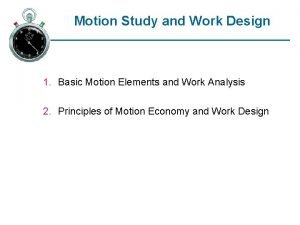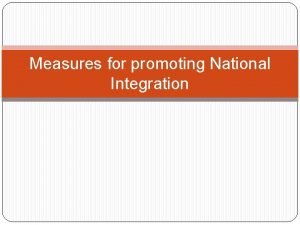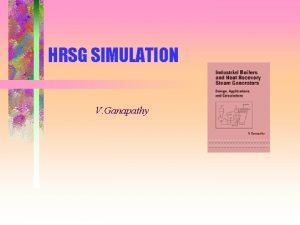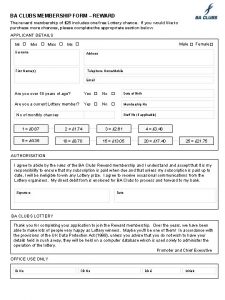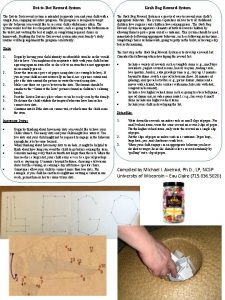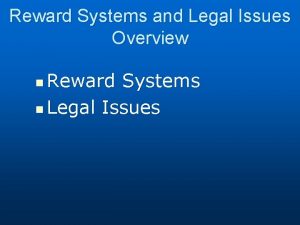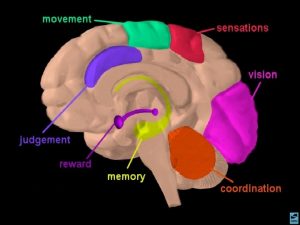Understanding rewards at HRSG 1 Principles Reward that
















- Slides: 16

Understanding rewards at HRSG 1

Principles: Reward that is in line with our … … performance q Recognising that superior performance needs to be balanced between the entity and the individual … values q Reinforcing the values and behaviours we aspire to, including; global mind-set, action not debate etc. … competitors q Ensuring we offer a competitive reward package in relation to those companies with whom we compete for talent … people beliefs q Supporting the importance of learning opportunity, mobility and building careers … leadership responsibility q Aligning reward outcomes so that reward for employees in more senior positions is increasingly weighted to variable pay, HRSG’s performance and the long-term … goal q Adopting equity to build increased ownership and sharpen employee focus on long-term and sustainable value creation The reward principles are closely integrated with our Values & Behaviours and People Beliefs 2

Your Total Reward The Annual Cash Bonus is in recognition of the Group’s, your entity’s, and your own performance for a year Total Direct Compensation Reflects your skills, knowledge, experience and value in relation to the market and relative to peers, taking account of performance Gross Salary Annual Cash Bonus • • Individual Experience Benefits Programmes will be broadly competitive in the local market Supporting employees in making health and lifestyle choices Culture Work Environment Opportunities for Growth • • • Provides employees with a valuable career offer, with broad ranging opportunities to learn and develop 3

Your Total Reward Link between Performance and Reward Strategic Ambition: Double Business in 05 years Key: Performance Culture Key: Strong performance management system clearly linked to reward “More stretch, more performance, more reward” This means, among other changes… § Gross Salary increases informed in part by performance ratings § Annual bonus opportunities for achievement of stretching performance goals § Direct connection between performance ratings and annual bonus 4

Pay for Performance Part 1 – Gross Salary Linking Gross Salary to Individual Performance An annual review of market pay movement influences a company’s overall Gross Salary Budget and pay scales, in the context of the overall HRSG annual budget. An annual review considers an individual’s position in their pay range. An individual’s Performance Rating against their 3+1 Goals is considered. Budget Individual’s Position in Range Performance Rating Gross Salary Proposal Therefore, any potential Gross Salary increase is influenced by market movements and the annual budget, and an individual’s Gross Salary position and Performance Rating. 5

Pay for Performance Part 2 – Annual Bonus Overview of Principles Size of Pie: Business performance determines the overall amount of money available for bonuses Size of Slice: Individual performance determines how much the employee gets from the available money What does that mean? 6

Pay for Performance Part 2 – Annual Bonus – Overview of Mechanics How is the size of the pie determined? Business Results § HRSG’s achievement within the Business Results range (from threshold to outstanding) will flex the overall amount of bonus money up or down. Following is the distribution to each component. • 40% Volume* • 40% Operating Margin * • 20% Working Capital * *HRSG must achieve threshold levels on both the Volume and Margin measures to fund 80% of the overall bonus pool. How is the size of my slice determined? § § § Line Managers have an initial budget which is the sum of each of their employee's target bonuses Line Managers make bonus proposals from this initial budget based on the performance rating assigned to each individual Line Manager proposals are adjusted either up or down based on the bonus fund the employee is assigned to AND the relative assessment of the business performance. See Process Flow on next slide. . And now let’s get into the details! 7

Pay for Performance Part 2 – Annual Bonus Overview of Process Business Employees BR Target Ranges Bonus Targets 1) Target Pool Pay-out 2) Line Manager Proposal based on Performance Rating (in context of Line Manager budget – based on target business performance) 3) BR Performance measured to determine actual size of pool 4) Money is re-distributed according to relative performance of business units resulting in a differentiation factor 5) Differentiation factor applied to Line Manager’s original proposal resulting in final bonus pay-out 8

Pay for Performance Part 2 – Annual Bonus - Size of Slice Line Manager Proposal Made based on Performance Rating Line Managers make a Bonus Proposal for an individual in a defined range based on the Performance Rating they have been given. To ensure there is no overspend, Line Managers are allocated a Budget which is the sum of the target bonuses of each member of their team. Line Manager proposals are balanced within an Organisation Hierarchy, similar to the current process. 1 0% - 3% Performance Rating 2 3 4 5 Target 5% - 10% 14% - 24% 26% - 35% 40% - 50% M 5 Proposal 18% All figures above are illustrative only M 4 M 3 M 2 9

Pay for Performance Part 2 – Annual Bonus - Size of Slice Individual Differentiation The relevant Performance Cluster’s differentiation factor is applied to the Target proposal to determine the final pay-out Example 277, 200 Bonus Outcome in PKR 27. 72% Differentiated Proposal 1. 54 Differentiation Factor 18% Target Proposal Annual Gross Salary 1, 000 Remember: 1. Assumed that the business performance has a differentiation factor of 1. 54 2. Once calculated, differentiated proposals will be reviewed for appropriateness 10

Pay for Performance Part 2 – Annual Bonus Summary § All bonuses are distributed via a Line Manager Budget which is initially aligned to the Target Bonus of each employee in the Line Manager’s team. § Spend is managed by balancing within an Organisational Hierarchy similar to today. § The Line Manager awards a proportion of his/her target budget to each of his/her team based on the relevant pay-out range according to the employee’s Performance Rating. § The Line Manager’s initial proposals will be adjusted up or down dependent on Business Results achievement and Performance Cluster Differentiation. In essence. . HRSG’s overall performance determines the total amount of money available for bonuses. The performance of the employee’s relevant business determines its share of the available money. The employee’s individual performance determines his/her share from the business’s available money. 11

The Leadership Differentiation Tool Overview The LDT is one of the enabling tools in achieving a high performance culture. The LDT assessment is based on judgement and supported by facts. HOW It is a well established tool within the business, and is widely regarded by Line Managers as a simple and effective method for assessing sustained performance over a 2 year period. Consistently demonstrates outstanding leadership Consistently demonstrates leadership at the expected level Does not demonstrate leadership at the expected level. Fails to meet stretching performance targets. Consistently meets stretching performance targets. Consistently exceeds stretching performance targets. WHAT 12

The Leadership Differentiation Tool Overview A person’s position on the matrix is based on the judgement of their Line Manager, supported by evidence. The “How” axis is informed by the person’s SOL 360 and GPS ratings together with other evidence of their overall leadership. However, the factual evidence DOES NOT map directly onto the axis: Leadership Judgement is key. HOW The “What” axis is informed by a person’s delivery against key business measures and critical deliverables (including their 3 Work Plan goals). Performance ratings will also inform their position on this axis. Consistently demonstrates outstanding leadership Consistently demonstrates leadership at the expected level X Does not demonstrate leadership at the expected level. Fails to meet stretching performance targets. Consistently meets stretching performance targets. Consistently exceeds stretching performance targets. WHAT 13

The Leadership Differentiation Tool The LDT Scorecard Overview A standardised scorecard is planned to be introduced to ensure that factual evidence supports the assessment process. This scorecard was piloted at M-2 in the 2011 LDT assessment round. e pl am Ex 14

The Leadership Differentiation Tool Calibration The Key word in the name of this tool is “Differentiation”. It is used to identify the Top Talent within a Peer Group. um im ax M ox pr % 60 HOW % 25 Ap um % 15 Does not demonstrate leadership at the expected level. m i in Therefore, Calibration Meetings take place in which Line Managers’ proposals are adjusted to fit into the distribution shown here. These are enforced distributions. Consistently demonstrates leadership at the expected level M Therefore, unlike Performance Ratings which assess individual performance against individual goals and job standards, the LDT measures performance relative to a Manager’s peer group. Consistently demonstrates outstanding leadership Fails to meet stretching performance targets. Consistently meets stretching performance targets. Consistently exceeds stretching performance targets. WHAT 15

The Leadership Differentiation Tool Other uses of the LDT In addition to supporting GPSP proposals, the Leadership Differentiation Tool: § Rationalises key decisions regarding the deployment of talent and alignment of our top talent to our most leveraged roles. § Enables us to identify opportunities to upgrade the talent pool. § Provides input to the development planning process by identifying strengths and weaknesses against the two axes. § Helps in the identification of HP and SHP talents by highlighting exceptional performance and strong leadership. 16
 Hrsg boiler diagram
Hrsg boiler diagram Vertical hrsg
Vertical hrsg Gây tê cơ vuông thắt lưng
Gây tê cơ vuông thắt lưng Block nhĩ thất độ 2 type 1
Block nhĩ thất độ 2 type 1 Tìm độ lớn thật của tam giác abc
Tìm độ lớn thật của tam giác abc Sau thất bại ở hồ điển triệt
Sau thất bại ở hồ điển triệt Thơ thất ngôn tứ tuyệt đường luật
Thơ thất ngôn tứ tuyệt đường luật Hãy nói thật ít để làm được nhiều
Hãy nói thật ít để làm được nhiều Thơ thất ngôn tứ tuyệt đường luật
Thơ thất ngôn tứ tuyệt đường luật Tôn thất thuyết là ai
Tôn thất thuyết là ai Phân độ lown ngoại tâm thu
Phân độ lown ngoại tâm thu Walmart thất bại ở nhật
Walmart thất bại ở nhật 17 therbligs
17 therbligs Promoting national integration
Promoting national integration Risk/reward quest
Risk/reward quest Violation valence
Violation valence Role of reward system
Role of reward system












